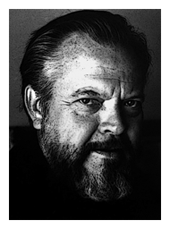Your Planets
Portraits of the Planets
Aspects between Planets
The planetary ages
The planetary families
Planets in Signs
The Planets in comics


Orson Welles, a cult figure in the cinematographic pantheon, remains forever an artist apart, unclassifiable, overwhelmingly brilliant, and yet the mystery surrounding both his work and his life remains intact. Whoever took as his motto Picasso’s phrase “Art is a lie to tell the truth”, explored to the end the ability of cinema to tell us the truth while keeping us in illusion.
.png)
.png)
.png)
 Orson Welles’ career began with a lie. Everyone knows the famous joke he played on all the American people by interpreting on the radio an adaptation of War of the Worlds, by H. G. Wells. Amazed by the man’s strength of conviction and talent as an actor, the (uncultivated) listeners believed that the Martians were really landing on our planet! Ironically, Welles apologized, while chuckling, because he knew he had just pulled off a hell of a job! It is indeed at this moment that the genius of Welles really burst. From that moment, all his work will be only a continuation of this bet: to manage to create in the public a malaise… From this malaise which arises from the abolition of the border which separates the true from the false, the life of its representation, the reality of comedy.
Orson Welles’ career began with a lie. Everyone knows the famous joke he played on all the American people by interpreting on the radio an adaptation of War of the Worlds, by H. G. Wells. Amazed by the man’s strength of conviction and talent as an actor, the (uncultivated) listeners believed that the Martians were really landing on our planet! Ironically, Welles apologized, while chuckling, because he knew he had just pulled off a hell of a job! It is indeed at this moment that the genius of Welles really burst. From that moment, all his work will be only a continuation of this bet: to manage to create in the public a malaise… From this malaise which arises from the abolition of the border which separates the true from the false, the life of its representation, the reality of comedy.
On 30th October 1938, Orson Welles underwent several important transits: the passage of Jupiter on its Moon-Uranus conjunction, of Saturn on its Mars-Venus conjunction, and of Uranus on its Sun-Mercury conjunction. So many symbolic configurations of a strength (or farce…) of extraordinary conviction at the same time as an aesthetic questioning in the making (Citizen Kane will come two years later).
Born on 6th May 1915, at 13:00 UT, in Wisconsin, Orson Welles had a chart marked by two angular configurations: a conjunction Saturn-Pluto dissonant to the Ascendant, and a conjunction Moon-Uranus in Aquarius in Midheaven. The latter was the square of a conjunction Sun-Mercury in Taurus, and at the sextile of a Mars-Venus conjunction in Aries. The planet “blind” of the chart was undoubtedly Neptune.
From the outset, we notice above all that the dominant position of Saturn-Pluto in House I, whose formula is “Subject Representation”, perfectly sums up the work and life of this genius of the seventh art. Indeed, to sum up this configuration, we can say that it is entirely centered on an absolute critique of any possibility of defining the identity of any subject, starting with oneself. Saturn-Pluto dissonant, it is complexity promoted as a mode of knowledge, it is the search without illusion for a truth that we know in advance is elusive. Saturn explores with uncertainty a universe in advance denatured, disenchanted, insane, by Pluto, symbolic master of the Underworld, Illusions and Darkness of the Unknowable. The great lesson transmitted to us by Welles, through his greatest works (Citizen Kane, The Splendor of the Ambersons, Mr. Arkadin, etc.), is that the secret of beings always eludes us. The testimonies, the speeches, the images supposed to inform us about the identity of a subject are on the contrary only false leads, elements of a puzzle that we can never complete. This is the first and last image of Citizen Kane, this panel “No tresspassing”, prohibition to enter, which forever prohibits any journalistic desire to push the investigation to the end. Of a man, one can only know bits and pieces.
Hundreds of mirrors can only be used to create hundreds of reflections. But no picture will be right, complete or definitive. death takes all, and first of all the secret of beings. Unsurprisingly, we can see that the other dominant aspect of Welles’ chart, the conjunction Moon-Uranus, which represents the desire to create new forms and impose a revolutionary style, is found in Aquarius, but above all also in House IX, that of the “Transcendence of the Subject!”
Saturn-Pluto in “Subject Representation”, it is this idea that any attempt to define anything in this world is doomed to failure, since the world itself is only illusion, bluff and nonsense. In a recent essay by Youssef Ishaghpour titled Orson Welles, a visible camera, we can read: “The self-portrait he gave in ‘Truths and Lies’: charlatan, magician, forger, huckster, thus becomes a godsend. Instead of questioning the meaning of this, for Welles, in relation to a world of falsehood created by the generalized representation and circulation of the image-information-commodity, which destroys the work, the artist and the reality at the same time, we exhibit this portrait as proof of truth.”
Long before Guy Debord and his criticism of the society of the spectacle, Orson Welles was able to demonstrate that the advent of representation was in fact a real massacre for all those who know that the truth is not visible and that everything we see is only a lie. In the system R.E.T., we know that the level “Representation” is the most basic, the most simplistic, and that the level “Transcendence” is the one that comes closest to a hypothetical “truth”.
Regarding Youssef Ishaghpour’s essay, the Inrockuptibles write: “If some see in Welles only a supporter of the Baroque, Ishaghpour, for his part, prefers to link the filmmaker to Mannerism and considers that “by his Copernican revolution, which opposes subjectivity to foundation, Welles is essentially a modern”. So, either as the ‘squanderer’ of a classical form, or as an innovator who transformed the image, ‘mirror of the world’, into ‘mirror of the subject’, Welles is incontestably a pivotal filmmaker, even a motor of the revival of 7th european art”.
The average configuration of the chart, the conjunction Sun-Mercury in Taurus appears as that of the Wellesian obsession with the image, with communication, with its talking and manipulative bulimia. The mischievous Welles was an affable, funny and sweetly narcissistic character. But with Sun-Mercury dissonant to Moon-Dominant Uranus, we can say that Welles was concerned with going beyond and transcend its mercurial natural appeal for fantasy through a unique, rigorous and revolutionary creation. Citizen Kane was all of these. This is the work uranian par excellence: the one that renders obsolete all that has been done before, and the one that opens up the widest field to the innovators who will come later (Moon-Uranus in Aquarius).
“With this film, Welles will mark the transition between two periods of cinema. His innovative style, his advanced technique and his scenario will make this film a major work”, “with ‘Citizen Kane’, he delivers not only a good film, but ‘the film’, the one that would go against everything that had been done for 40 years”, can we read in the encyclopedias of cinema. Truffaut also said: “If silent cinema has brought us great visual temperaments: Murnau, Eisenstein, Dreyer, talking cinema has only brought one filmmaker whose style is immediately recognizable over three minutes of film, and his name is Orson Welles.”
In good Aquarius-versus-Taurus, Welles knew how to break traditions by working on instinct, following only his most unconditioned and original inspiration, to succeed in going beyond the learned canons of routine and slowness.
With a chart dominated by the level “Subject”, Welles has become the archetype of the subjective filmmaker, of the author who is not concerned with translating any reality, but rather with “say”, to translate the poetic nature of things, like a Shakespeare or a Kafka (two of his favorite authors). “In absolute agreement with the characters he presents, Welles expresses himself in a strong, unusual style, of a sometimes delirious expressionism which, by its accumulation of signs, joins the purest baroque… This accumulation of external signs, this excess, this continuous charge dazzle, fatigue. They are not always necessary for the meaning of the plan, but are the basis of a style, that of excess.”
Ogre Taurus in contradiction with an Aquarius pole, Welles was a filmmaker of obsession (that of power, revenge, passion, jealousy, etc.). Sometimes, he used this negative induction specific to Taurus: his interpretation of the rotten cop in The thirst for evil strongly demonstrates this. In this sticky and dark film, he plays the role of a misanthropic policeman, Quinlan, relentless in pursuing his goal (personal revenge) by any means possible. When he dies, a woman will say: “he was a dirty cop, but a good guy.” Shakespearian heroes also served him to express the full extent of an extreme character, proud, authoritarian, blinded by passion (Othello, Falstaff, etc.)
With Mars-Venus in Aries as a weak configuration, Orson Welles was in fact a workaholic secretly driven forward by rampant emotionality, capricious touchiness. At the same time, the great Wellesian characters are just big children who want to make the world their playground (Kane, Arkadin). Basically, “these potentates surrounded by mystery move in a baroque and monstrous world while carrying in their heart a pure corner. For Kane, it was his childhood (symbolized by the ‘Rosebud’ sled), for Arkadin, it was his daughter” (Encyclopedia Universalis).
Welles is arguably one of the greatest filmmakers of all time, and one of the most influential artists of the past century. Like all revolutionaries, he was also a being full of contradictions and weaknesses who literally got smashed by the system, money and the standardization of art forms, via the mass media. He is the filmmaker of the complexity of understanding the universe and understanding ourselves. He had the merit of confronting his talent with the hard and thankless duty of lucidity. This lucidity that places us face to face with our own unknowable. Welles said too much, did too much, but it was above all to show us that we should not listen to anyone, and above all not believe in the ready-made truths of the chimera merchants. Welles is the filmmaker of lost innocence, but rediscovered magic…
Article published in issue No. 16 of the Fil d’ARIANA (October 2001).

Le petit livre du Taureau
par
49 pages. Illustrations en couleur.
Ce livre présente et explique les trois zodiaques : celui du décor des constellations, celui de l’astrologie traditionnelle basé sur les Quatre Éléments symboliques (Feu, Terre, Air & Eau) et celui de l’astrologie naturelle basé sur les phénomènes astronomiques objectifs.
Interprétation du Taureau selon la symbolique classique et selon ses réflexes dans le zodiaque naturel (force, vitesse, équilibre) ; interprétation du Taureau en fonction des planètes dominantes ; le Signe solaire & le Signe Ascendant.
Téléchargez-le dès maintenant dans notre boutique